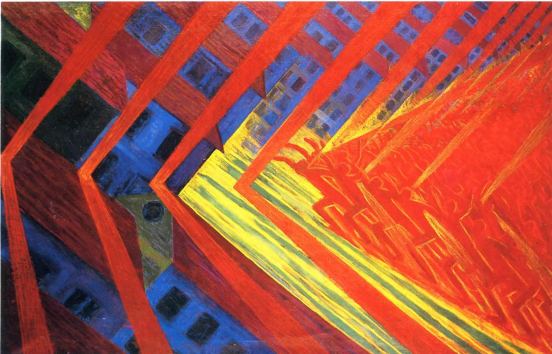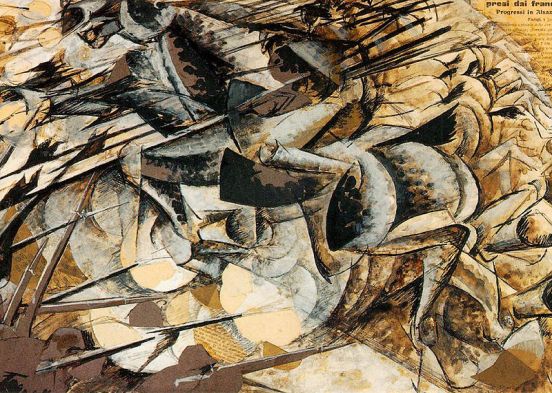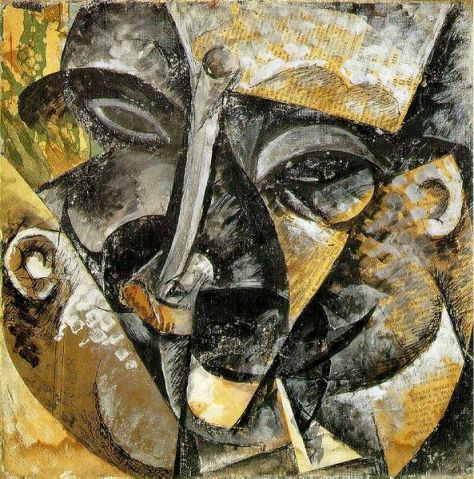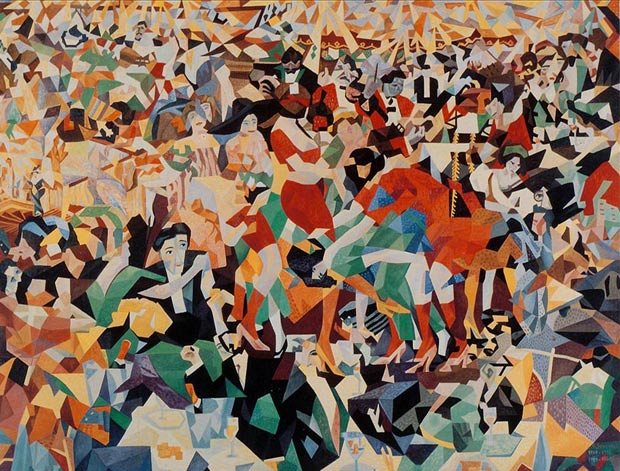Futurism’s name is kind of self-explanatory – it was the early 20th century idea of how the future would be. The movement was founded in 1909 by the Italian poet – F. T. Marinetti – in his ‘Futurist Manifesto’ based on the principles of love of technology, speed, and violence. Marinetti would later start the Futurist Political Party, become a supporter and associate of Benito Mussolini (and his Fascist Party), and then become co-writer of the Fascist Manifesto. When Hitler’s degenerate art show tried to enter Italy and also tried to include futurist art within the exhibition, Marinetti persuaded Mussolini to put a stop to it. Marinetti’s part in Mussolini’s regime had resulted in some level of acceptance of modern art in the country.
“The Revolt”, Luigi Russolo, 1911
In case that wasn’t enough of a hint, here is a quote from the Futurist Manifesto, which will probably give you a very clear idea of Marinetti’s world view:
“We want to glorify war — the only cure for the world — militarism, patriotism, the destructive gesture of the anarchists, the beautiful ideas which kill, and contempt for woman.”
To be honest, the manifesto itself is bonkers (there’s a translation of it here). It’s full of grandiose statements – how we should destroy museums and libraries and any connections to our history, put a stop to feminism and morality, and embrace industry, machinery, youth, rebellion and so on.
“Charge of the Lancers”, Umberto Boccioni, 1915
Stepping away from the political madness, futurism brought some very interesting art into the world. A key artist from the movement was Umberto Boccioni, who is closely associated with ‘dynamism’ – the futurist way of describing the motion of an object. Boccioni often worked with collage, combining found papers with loose brushstrokes and abstract shapes, and the results definitely had a sense of movement.
“Dynamism of a Man’s Head”, Umberto Boccioni, 1914
Presumably Boccioni had similar views to Marinetti, but we don’t really get to see them develop – he died in 1916 as a result of a training exercise, having been drafted to fight in World War I. It would have been interesting to see where his work would have gone, especially by the 1940s.
Another key futurist was Gino Severini, who had met Boccioni while they were both studying under Giacomo Balla (who was teaching them divisionist painting techniques), and was later invited by Boccioni and Marinetti to help found the movement. Severini was very into dynamism but not interested in machinery, so he would primarily study the movement of people. I think his best work is the one below, which was originally painted in 1909-1911 but accidentally destroyed in Berlin in 1926. He later repainted it in 1959-1960:
“The Dance of the Pan-Pan at the “Monico””, Gino Severini, 1909-11/1959-60
I think the reason why it appeals to me is that it’s capturing the essence of a situation without being a perfectly accurate representation of it. It’s tells the story pretty well – crowds of dancers and musicians and people sitting at their tables drinking, the overall mess of sight and sound that goes with a night out.
The poet Apollinaire criticised the futurists as being pretentious and provincial (which Severini would later agree with), and based on what I’ve read about them, I think he has a point. Ideologically they seem a bit like a group of annoyed teenagers, but I think they make up for it a bit with their artistry. It basically died out when Marinetti died in 1944, but during its time it influenced art deco, vorticism, surrealism and dada (and much later, the design of the city in Blade Runner).
Links:
http://iandimusic.com/weeklynoise/wp-content/uploads/2011/01/gino-severini.jpg
http://vserver1.cscs.lsa.umich.edu/~crshalizi/T4PM/futurist-manifesto.html



